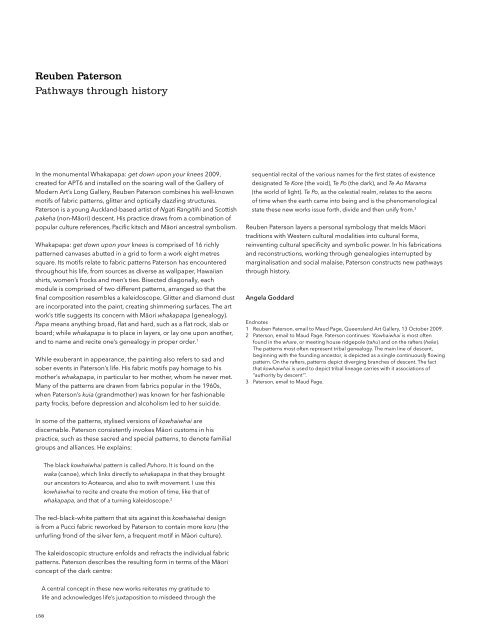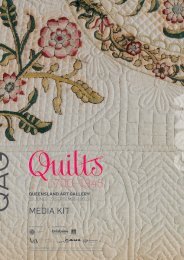Queensland Art Gallery - Queensland Government
Queensland Art Gallery - Queensland Government
Queensland Art Gallery - Queensland Government
You also want an ePaper? Increase the reach of your titles
YUMPU automatically turns print PDFs into web optimized ePapers that Google loves.
Reuben Paterson<br />
Pathways through history<br />
In the monumental Whakapapa: get down upon your knees 2009,<br />
created for APT6 and installed on the soaring wall of the <strong>Gallery</strong> of<br />
Modern <strong>Art</strong>’s Long <strong>Gallery</strong>, Reuben Paterson combines his well-known<br />
motifs of fabric patterns, glitter and optically dazzling structures.<br />
Paterson is a young Auckland-based artist of Ngati Rangitihi and Scottish<br />
pakeha (non-Māori) descent. His practice draws from a combination of<br />
popular culture references, Pacific kitsch and Māori ancestral symbolism.<br />
Whakapapa: get down upon your knees is comprised of 16 richly<br />
patterned canvases abutted in a grid to form a work eight metres<br />
square. Its motifs relate to fabric patterns Paterson has encountered<br />
throughout his life, from sources as diverse as wallpaper, Hawaiian<br />
shirts, women’s frocks and men’s ties. Bisected diagonally, each<br />
module is comprised of two different patterns, arranged so that the<br />
final composition resembles a kaleidoscope. Glitter and diamond dust<br />
are incorporated into the paint, creating shimmering surfaces. The art<br />
work’s title suggests its concern with Māori whakapapa (genealogy).<br />
Papa means anything broad, flat and hard, such as a flat rock, slab or<br />
board; while whakapapa is to place in layers, or lay one upon another,<br />
and to name and recite one’s genealogy in proper order. 1<br />
While exuberant in appearance, the painting also refers to sad and<br />
sober events in Paterson’s life. His fabric motifs pay homage to his<br />
mother’s whakapapa, in particular to her mother, whom he never met.<br />
Many of the patterns are drawn from fabrics popular in the 1960s,<br />
when Paterson’s kuia (grandmother) was known for her fashionable<br />
party frocks, before depression and alcoholism led to her suicide.<br />
sequential recital of the various names for the first states of existence<br />
designated Te Kore (the void), Te Po (the dark), and Te Ao Marama<br />
(the world of light). Te Po, as the celestial realm, relates to the aeons<br />
of time when the earth came into being and is the phenomenological<br />
state these new works issue forth, divide and then unify from. 3<br />
Reuben Paterson layers a personal symbology that melds Māori<br />
traditions with Western cultural modalities into cultural forms,<br />
reinventing cultural specificity and symbolic power. In his fabrications<br />
and reconstructions, working through genealogies interrupted by<br />
marginalisation and social malaise, Paterson constructs new pathways<br />
through history.<br />
Angela Goddard<br />
Endnotes<br />
1 Reuben Paterson, email to Maud Page, <strong>Queensland</strong> <strong>Art</strong> <strong>Gallery</strong>, 13 October 2009.<br />
2 Paterson, email to Maud Page. Paterson continues: ‘Kowhaiwhai is most often<br />
found in the whare, or meeting house ridgepole (tahu) and on the rafters (heke).<br />
The patterns most often represent tribal genealogy. The main line of descent,<br />
beginning with the founding ancestor, is depicted as a single continuously flowing<br />
pattern. On the rafters, patterns depict diverging branches of descent. The fact<br />
that kowhaiwhai is used to depict tribal lineage carries with it associations of<br />
“authority by descent”’.<br />
3 Paterson, email to Maud Page.<br />
In some of the patterns, stylised versions of kowhaiwhai are<br />
discernable. Paterson consistently invokes Māori customs in his<br />
practice, such as these sacred and special patterns, to denote familial<br />
groups and alliances. He explains:<br />
The black kowhaiwhai pattern is called Puhoro. It is found on the<br />
waka (canoe), which links directly to whakapapa in that they brought<br />
our ancestors to Aotearoa, and also to swift movement. I use this<br />
kowhaiwhai to recite and create the motion of time, like that of<br />
whakapapa, and that of a turning kaleidoscope. 2<br />
The red–black–white pattern that sits against this kowhaiwhai design<br />
is from a Pucci fabric reworked by Paterson to contain more koru (the<br />
unfurling frond of the silver fern, a frequent motif in Māori culture).<br />
The kaleidoscopic structure enfolds and refracts the individual fabric<br />
patterns. Paterson describes the resulting form in terms of the Māori<br />
concept of the dark centre:<br />
A central concept in these new works reiterates my gratitude to<br />
life and acknowledges life’s juxtaposition to misdeed through the<br />
Reuben Paterson<br />
New Zealand b.1973<br />
Whakapapa: get down upon your knees 2009<br />
Glitter and synthetic polymer paint on canvas /<br />
16 canvases: 200 x 200cm (each) / Image courtesy:<br />
The artist and Gow Langsford <strong>Gallery</strong>, Auckland /<br />
Photograph: Schwere Webber<br />
158 159
















